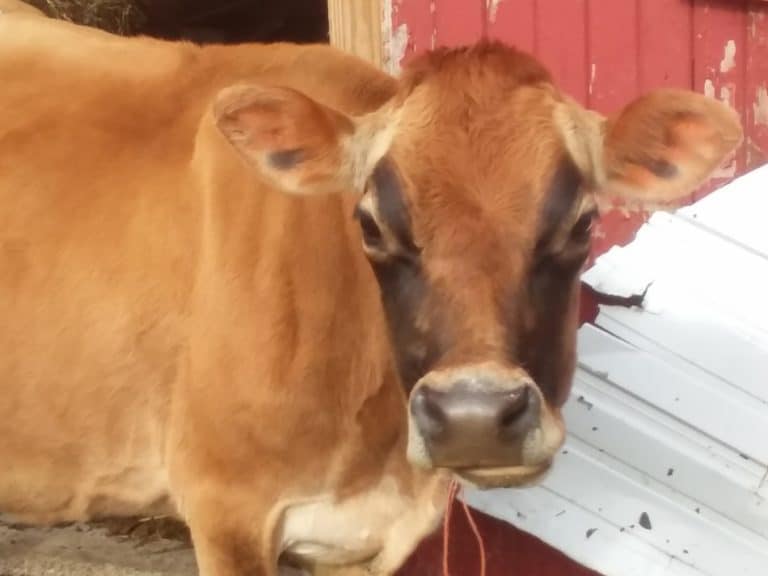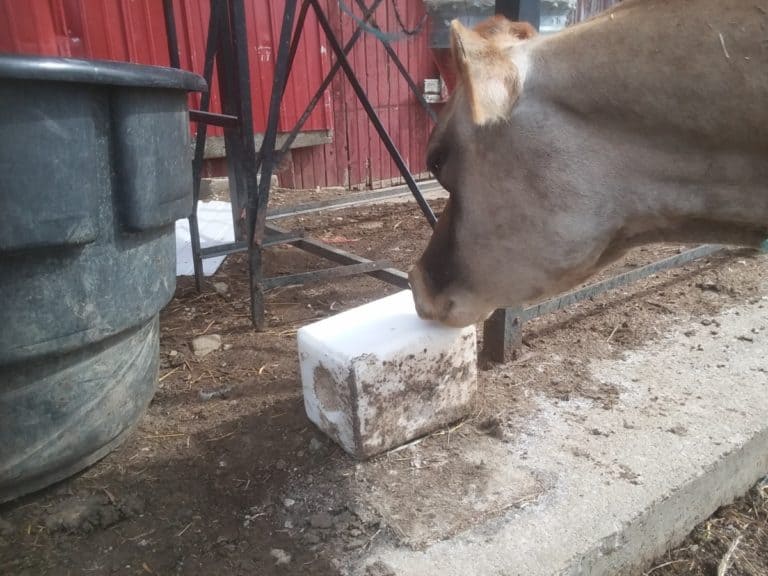A Family Cow: How To Choose And Take Care Of Her
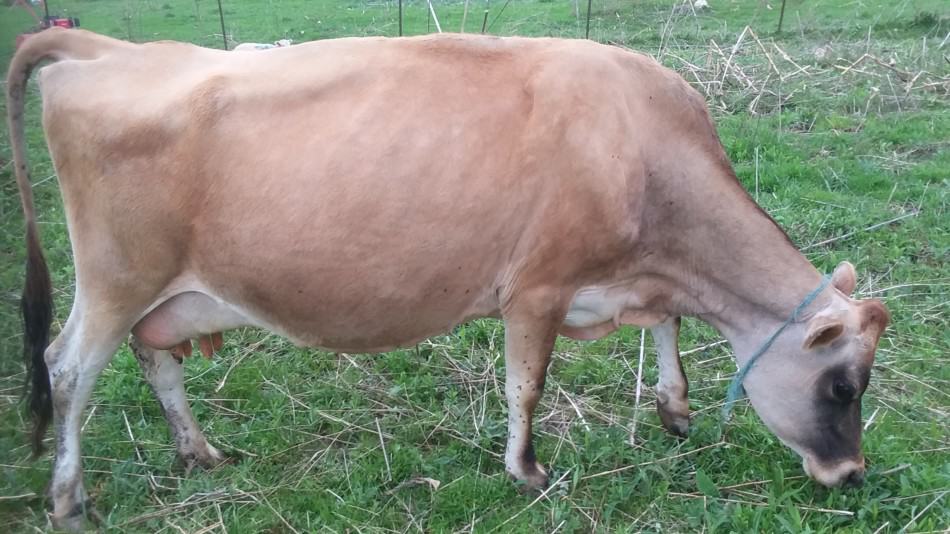
Wow, is this exciting! Considering getting a family cow is a huge step towards self sufficiency, not to mention a big leap into nutrient dense food for you and your family!
Now, how to choose? What things matter and what things are not a big deal?
Your family cow needs to be easy going, healthy and structurally correct and given 4% of her bodyweight in forage everyday.
How do you know if you’re ready? My guide “Are You Ready For A Family Cow?” will walk you through the things you need to have figured out, including feeding needs and daily care, before you get your cow.
5 Best Breeds Of Family Cows shows you my top picks for anyone just getting started with milking!
This article has two checklists and then explanation of those lists and why they are important to you.
You want to get a cow that will work for you and your management style and one that is easy to handle. Not to mention, easy to milk!
It’s worth waiting a few months for a cow to be ready to sell than charging ahead and getting one that will not be suited to your needs.
Let’s look into what you’ll need and what you should be looking for in a cow.
Are You Ready For A Family Cow? Checklist
| done! | needed for your cow | comments |
| research | know what she needs before you start to look at potential cows, take a hard look at your schedule and determination level a cow needs and deserves your full commitment | |
| money | high quality livestock will be worth more than average or low quality livestock expect to pay a little more than the average cost for cattle in your area | |
| place to live | she will need an area to be milked in and for winter living quarters, she will also need shelter out in her pasture from wind, rain and sun | |
| a friend | cows are herd animals, she will need a friend of some sort, it doesn’t have to be another cow | |
| hay and feed | she will need hay and grain (if using) calculate the hay and grain she will need compared to your barn space available |
Cow Health and Structure Checklist
| done! | HEALTH | reasons and explinations |
| overall | step back and look at the whole animal is she pleasing to the eye and generally healthy | |
| eyes | bright and clear, deal breakers: discharge or tearing | |
| nose | clean and wet deal breaker: mucous (like she has a cold) | |
| hair | shiny, short and smooth (summer coat) deal breaker: hairless patches of skin there are a few likely causes none are good | |
| manure | pile should be thick like pudding deal breaker: runny manure or solid chunks | |
| STRUCTURE | how her body is put together | |
| legs | front: straight and clean (no lumps) rear: hocks directly above foot (vs off to the side) front and rear hooves should be worn evenly | |
| topline | straight across from shoulder to tailhead dipped down is acceptable but not great deal breaker: hunched up spine | |
| girth | view at front or rear (not side): big, round belly deal breaker: flat sides (not eating well) | |
| movement | watch her walk stride should be smooth and free moving | |
| UDDER | mostly viewed from the rear | |
| four quarters | all four quarters are full and work well if milking now: check the milk from each one if dry: do not test milk any teats, just look deal breaker: non working quarters, huge discrepancies in udder shape, steep inclines | |
| well divided cleft | from front to back easily seen divide in udder deal breaker: no division between sides | |
| teats | straight and long, pointing down, soft skin, nicely tapered ends, small hole in end deal breaker: rough or cut off ends, chapped skin | |
| support | udder floor should be above the hocks, entire udder “up in” the cow deal breaker: super low udder (like it was glued on the outside of the cow as an afterthought) |
*DEAL BREAKERS* Deal breakers are huge red flags indicating something is wrong. A deal breaker is a problem that disqualifies the cow. If you notice a health related deal breaker leave the farm.
In the charts above, the first chart is for you to use at home when you are considering getting a family cow.
The second chart is for you to use when evaluating potential family cow candidates at their home farm.
Family cows are wonderful!
Congratulations! Deciding to get a family cow is a huge step towards self sufficiency!
Once you and your new cow settle in to a routine you will have a wonderful addition to your family.
How do you know if you’re ready? My guide “Are You Ready For A Family Cow?” will walk you through the things you need to have figured out, including feeding needs and daily care, before you get your cow.
Feeding Your Family Cow goes over your feeding plan for your best milker!
Our family cow is a Jersey
We have a Jersey named Aleene that is a wonderfully calm, easy going cow.
We let her just mill around the barnyard and she goes where she pleases, for the most part.
She is restricted a little in that she can not go in any area that has feed, since she will pig out and make herself sick!
When she is hungry she eats grass or hay when she wants to lay down she picks her favorite spot and takes a break.
We have a few other cattle, kept separately
We have a few other cattle but we keep Aleene out of their pasture. When she is in with them she will, of course, wander off with the herd.
This makes tracking her down at milking time difficult, especially when it is dark.
Plus, if she is in with the others at milking they will come over and investigate the situation during milking.
This usually means bothering the person doing the milking and pushing around on Aleene. Frustrating and wasteful, since the milk usually spills.
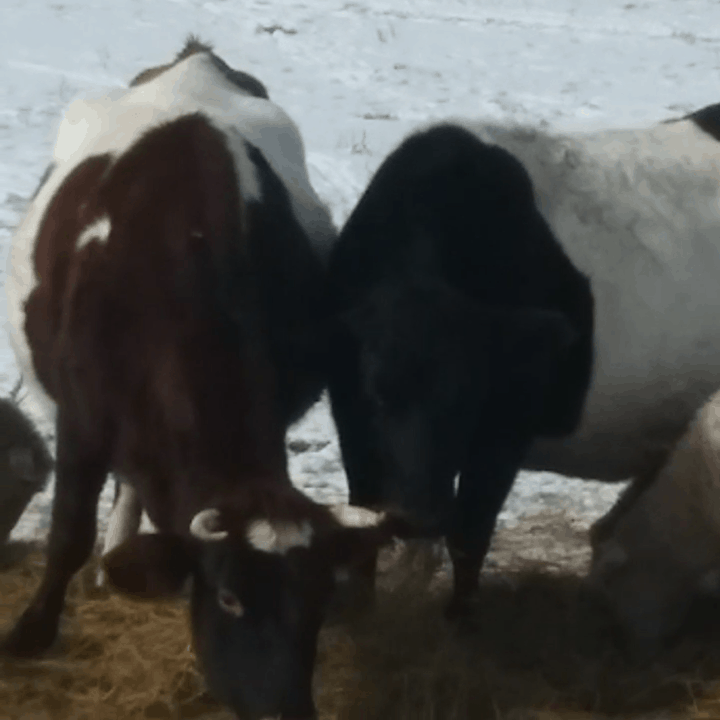
The family cow is not the boss out there.
If Aleene were the bossiest cow, milking her with the others might work because they would respect her space.
As is they push her around, proving that at least according to the other cattle she’s definitely not the bossiest!
Determine if you are ready for a cow
A family cow is a serious time and money commitment to your own health and well being as well as the health and well being of the cow. Are you ready for it?
You don’t get holidays off (neither does she)
The cow will need you when it is hot, cold, your birthday, when you are sick and when the kids had you up the past three nights because they are sick.
No last minute vacations, or spur of the moment stay over night outings, your cow needs you.
Also, consider that getting a helper to watch your animals when you leave town is much harder when you have a cow to milk. It’s not that milking her is hard, it’s that most people don’t know how to do it.
We love cows and are stay at home type people, so this is not a big deal for us. If you like to travel around, heavily consider how you will handle your cow’s care when you are gone.
How do you know if you’re ready? My guide “Are You Ready For A Family Cow?” will walk you through the things you need to have figured out, including feeding needs and daily care, before you get your cow.
Cows love routine
If you are not normally a routine kind of person you will need to be once you get your cow. Cows love routine and dislike disruptions to that routine.
For her own health, and to keep up milk production, she needs to be milked at the same time or very close to it every day, twice a day for about ten months.
Are you willing to make it happen?
Family Cow: Getting Her Bred Back goes over one of the bigger obstacles new folks have. It’s really not hard to find help, you just have to know who to ask. I’ll help you find the people who can help you out here.
You’ll need cash to purchase your cow
As I write this article cattle prices are actually pretty low overall, but for a high quality family cow the price will never be low.
Just like anywhere else you get what you pay for.
An above average cow will be above average in price.
Want a great cow? Plan to spend more than average cattle price to get her. Look at auction results or breed specific cattle sales to get an idea of price.
Your area and current demand will make cost very widely. Especially if you are thinking a special breed that is not very common.
You are looking for a special animal that will be easy to work with and will milk well for you and your family for years to come. Please do not cheap out here.
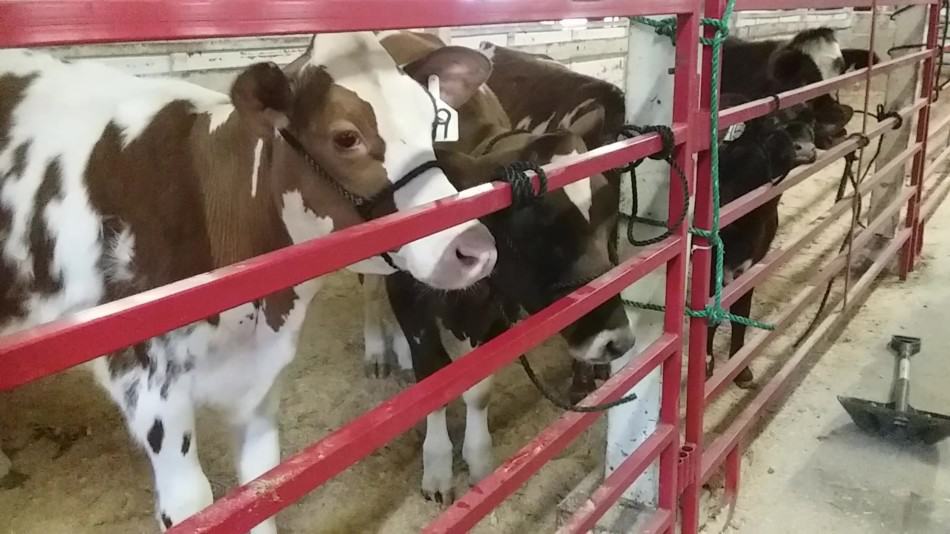
Research dairy cows and their needs
Look into dairy cattle as a whole and investigate some of the different breeds.
Start to get a feel for what you might like and what you are looking to stay away from.
You will need stall space for the cow
For example are you restricted on space in either the pasture or the barn? If so a smaller cow will make more sense.
Or maybe you want a bigger breed so you will be able to raise a bigger calf for the freezer.
There are no right or wrong answers here, only what will work best for you and your family.
You will need storage space for hay
Do some basic calculations to figure out just how big of a stack is a month’s worth of hay bales. Where are you going to put it?
Unless you are good at visually estimating space (I’m not) then get out a measuring tape and see exactly how much space you have so you can estimate what it will hold.
Look on the internet for hay. Will you be able to get the hay delivered to your barn or do you need to have a way to haul it?
Ask at the farm supply store about getting hay and straw (bedding). While you are there look around and see what else you might need, like feed pans or buckets.
Your cow needs a place to bed down
A cow is not overly picky about where she lives.
She wants to have a spot where she gets plenty to eat, has all the water she needs to drink and shelter from the elements, mostly rain, snow and wind.
If it’s hot she will want a place to get out of the sun.
Daily Care Of Your Family Cow goes over your routine, you know she loves a routine! And so will you, once you get a system that works for you set up!
She needs a comfortable place to lay down.
A large portion of your cow’s day will be spent laying down chewing her cud.
She will need a comfortable area where she has ample room to easily get up and lay down. She can and will rest out it the pasture.
If the barn will be open for her to come and go as she pleases then the area she has available to her inside needs to be bedded down.
Cattle do not like slippery floors
Cows do not like slippery floors, especially when she is trying to get up, so have plenty of bedding down on the cement.
If your cow will be walking on wet cement consider putting some grit on the cement. We used crushed limestone.
Just scatter a bit of the crushed limestone on the cement to give her traction, just like cinders on a slippery road helps your car tires.
She will need some shelter.
Unless the cold is severe, she just needs a draft free, clean stall or open part of the barn.
In the winter she will grow a thick hair coat to help keep her warm. She will need shelter, even if the beef cattle in your area stay outside all winter.
Most dairy cows need a place to be inside.
This is because a dairy cow does not naturally have the layer of fat insulating her body, like a beef cow, so she can not handle the cold unprotected.
Your cow will need a friend.
Your family cow is a herd animal and being such she will need a friend. This does not necessarily mean more cattle but she does need a buddy.
It could be a few sheep or goats, just a pal to hang out with so she won’t be lonely.
Your cow will eat 4% of her weight per day
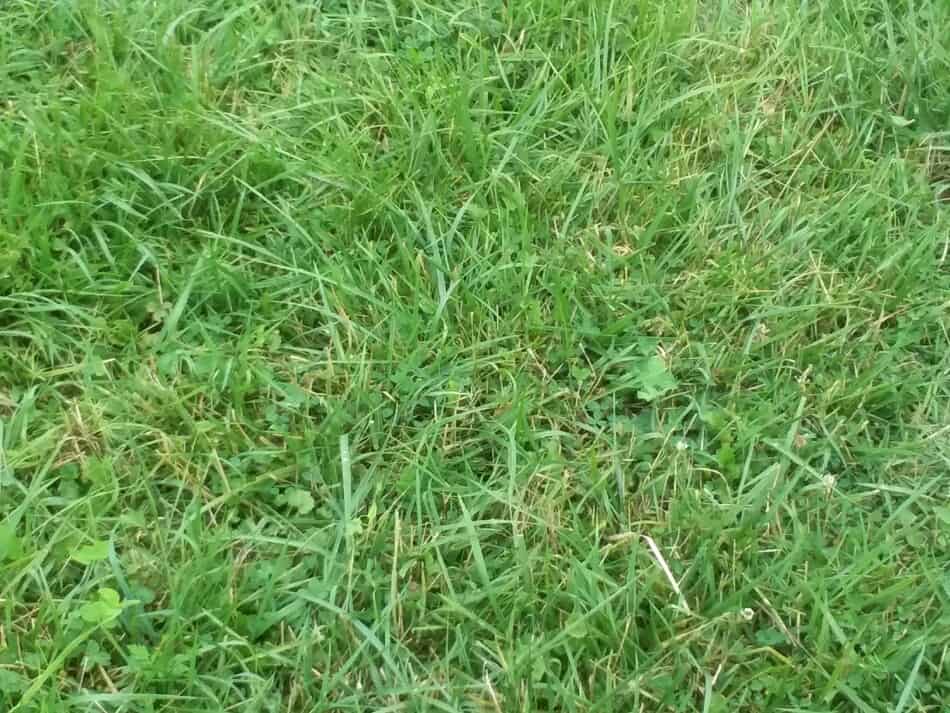
A cow eats 4% of her body weight in food per day. 4% is a good place to start but don’t get too hung up on this number being exact.
This is an average and just like you are not average neither is your cow. She may need more or less feed, you will need to adjust as you go.
She eats grass and hay
Her food can come as grass or hay. Some people like to feed a little grain.
Your cow has to take in a certain amount of calories a day to maintain her body weight and have energy to spare to make milk.
Look into hay yields for your area (the amount of hay you could expect per acre) and use this number to figure out how much of your pasture your cow will need to eat for the summer.
Grass not eaten in the summer can be eaten in the winter.
If you have extra land and grass, good news on nice days in the winter she will still have some grass to eat.
If you find out that you will be short on grass, then figure out how much hay you will need to purchase while you wait for the grass to regrow.
Grain can be used as a lure (a.k.a. bribery)
We do not generally give Aleene grain but she definitely knows what it is and loves to eat it.
This is handy if you need to lure her into a stall or away from something else, it’s just like giving your dog treats.
Your potential cow should look healthy.
It should be apparent to you that the cow you are considering is healthy. How can you tell? Here are some key areas to check.
- Eyes
- Nose
- Hair
- Manure
The cow’s eyes should be clear
The eyes of your cow candidate should be clear and bright. No cloudiness or discharge, even tears indicate something is not right and you should investigate further.
Maybe she just has dust in her eye or maybe she is starting to show the initial stages of pink eye. Your cow should have bright eyes, if not this is a deal breaker, go somewhere else.
The cow’s nose should be clean
Just like with people, kids especially nasal discharge means all is not well. Go to another farm if the cow looks like she has a cold.
Your cow’s hair should be shiny
Cows should have smooth, shiny hair in the late spring, summer and fall. In late fall, winter and early spring she will have her shaggy winter coat which is totally normal and healthy.
Look her over for round, rough, whitish patches of skin. This is ringworm, just like people get, and she can give it to you.
Your cow’s manure should be like pudding
If you can get a look at her manure. The ideal pile of manure (yes there is such a thing as an ideal pile of manure) will look like pudding with a small dent in the top of the pile.
Runny manure or hard manure that is in chunks are both bad news and both are deal breakers.
Cow body structure determines longevity
The way a cow is put together determines how long she will be able to live a healthy productive life, this includes her bone structure and her udder structure.
Judging Dairy Cattle is a University Of Kentucky article showing you some things to look for when you are picking out your cow, scroll down there are some easy to understand graphics you’ll want to be sure to see.
No cow is perfect in structure and some small flaws will not matter in a family cow. Here are the basics to look at:
Your cow’s legs should be straight and clean
Her legs should be straight and clean. By clean I mean no odd bumps. Front legs should be straight with equal length toes on each side of the hoof.
The hoof should not be overly long, think like a horse hoof.
Rear legs should go straight down so that the hocks (bend in the rear legs) are directly above the feet when you look at her from the rear.
Hocks being closer together or further apart than straight will make her move her legs in a way that will wear down her hooves oddly.
The hooves on the rear legs will be a bit shorter than those on the front.
Your cow’s topline should be level
Topline just means her back from her shoulders to the top of her tail. Her topline should be level.
Some cows do have a bit of a sag in their topline when they get older, not ideal but if she is otherwise good then okay.
Not so good in a young cow. A young cow with a sagging back shows that she is not holding up well. I would not buy her.
If she has a hunched up back something is wrong. This is the cow version of you laying half dead on the couch when you feel like junk.
If you are still considering her, stop. A rounded topline (hunched up back) is a deal breaker, go some where else.
Your cow’s girth should be full
Girth means measurement around the tummy. Your cow needs a lot of girth so she can fill up on food. This is like a car having a big gas tank so you don’t run out of fuel.
A big full girth shows that she is eating plenty of food so she will have the nutrients available to make milk.
This is especially important if you are hoping to feed grass and/or hay only.
It takes more volume of grass to get her energy needs each day than if you were giving her grain so she has to be able to eat more to make up the difference.
Your cow should move smoothly
Watch the cow move around a bit. Does she move freely and with a full stride?
Are her movements fluid or does her stride have a hitch in it like something hurts?
How does she stand? Are all four feet on the ground? This is normal for a cow.
Or is a leg cocked like a horse would stand? Normal for a horse, not normal for a cow.
Udder structure is critical for your cow
The udder has some special considerations and since the entire purpose of getting this cow is for the milk we’ll spend some time looking into udder structure.
Click here for my article giving step by step instructions for milking by hand.
Your cow’s udder needs built in support
The udder of a milking cow should be up in the cow, as in not hanging way down between her hocks. A cow with a dangly udder is said to have poor udder support.
Any time she moves around her udder will swing and bounce off her legs potentially causing injury as she moves faster, like running.
A cow’s udder is naturally divided in half
While standing behind the cow you will notice the udder is divided in half from front to back. This is good, showing more support.
The halves of the udder should be close to even.
Your cow’s teats should be long
The teats should hang straight down and have some length. This is something to watch out for if your cow has a commercial background.
This bigger dairies are all breeding for short teats. Short teats will cause you problems, go long.
The teat ends should taper nicely and have a small hole for the milk to come out of. The skin should be soft and supple.
Your cow should have four working quarters
She should also have all four quarters working. Being four quartered is not absolutely necessary, especially if you have a milking machine, but it is ideal.
A three quartered cow is harder to milk since one of your hands will do two quarters. A three quartered cow is also significantly less valuable than a four quartered cow if you were to resell her.
Buy a young cow, not a heifer
Deciding the age of the cow to purchase is an area where potential new cow owners start to make mistakes. Consider getting a cow and not a heifer.
A heifer is a gamble.
Choosing a heifer is a big gamble. Since she has never milked before you can not know how she will behave.
Maybe you will get lucky and find an unusually calm one. (It’s not likely.)
It’s more likely you will have quite the rodeo on your hands and regret getting a young inexperienced animal for inexperienced you to try to handle.
Get a cow with some experience.
The new cow owner needs a cow that knows what she is doing.
Everything you do will go more smoothly if one of you has some experience with this whole family cow thing.
Since you are he new one, she has to be the one who knows what is going on.
The ideal cow is used to hand milking
The ideal candidate should have already had a calf or two and have experience with being milked by hand, if you are going to milk by hand.
If she is used to machine milking she may or may not be an easy hand milker.
She should be a naturally calm individual that is in good shape. She also should be bred and confirmed pregnant.
Confirmed pregnant is huge. Just because she was bred, does not mean she settled (conceived). Unless you have easy access to a bull, this is important.
How do you know if you’re ready? My guide “Are You Ready For A Family Cow?” will walk you through the things you need to have figured out, including feeding needs and daily care, before you get your cow.
The best time to transport a cow is when she is dry.
The easiest time to move a cow to your place is when she is dry (not milking).
She will be dry for two months before she has her next calf then she will start milking again.
Getting a dry cow means waiting for milk
The down side of buying a dry cow is that you will not be able to test milk her to see how it goes and how she reacts.
You will also be the one to take care of her before and during birth and care for the calf once it is born.
Getting a fresh cow means you can try milking her
A cow that is fresh has just had her calf so she will be milking for the next ten months or so (assuming you get her bred back on time).
A cow that is currently milking will allow the opportunity to try your hand at milking her to see her temperament and ease of milking.
Does she stand still or shift around a lot?
How much effort do you need to put into the actual physical squeezing of the teat? Some cows are easier to milk than others, taking less effort from your hands.
How is teat length? Longer teats are easier to hand milk than short teats.
There is no best breed of dairy cow
Please do not get hung up on this one. The breed of the cow is no where near as important as the temperament of the individual animal.
Commercial cattle will produce more than you need.
Most commercial dairy animals are going to have you swimming in milk. These gals will also take more food to keep on weight.
That being said a lower producing individual or breed of dairy cow will be a better fit for a family cow.
Choose a cow that is calm and hardy.
The breeds that are listed as being more hardy, able to forage for themselves and have a calmer nature will be your best choices.
Also consider a crossbred cow. Crossbred cows can be real gems.
Family cow breeds to consider are hardy
Good breeds to start looking into are Jersey, Milking Shorthorn, Brown Swiss, Guernsey, Ayrshire, and Dutch Belted.
There are other more rare breeds that would definitely be suitable for your family cow, however rare breeds tend to come with an accompanying rare (high) price.
Click here for an article I wrote going into breeds of dairy cattle that may be suitable for your family cow.
Choose cattle common to your area
Generally speaking, it is best to go with a breed or cross breed that is more common in your area. Drive around and see what the locals have.
Ask to see what other small farmers are doing. Put an add on the internet. Go to the auction and see what normally sells there.
Do not buy your first cow at an auction
Do not buy from the auction unless you have a lot of dairy cattle experience! Auctions are always buyer beware. Since you are new, this is not the place to get your cow.
I’ll grant you that it is possible you will get lucky at an auction, but it’s much more likely that you will get a cow you can’t handle.
Your cow does not need to be halter broke
This is another major hang up for new cow owners. Please do not base your decision to purchase a cow on whether or not she is halter broke.
You do not need to lead your cow anywhere. When we need to move Aleene we just “shoo” her around or lead her in with food.
We do have a twine collar on her for the times when she is uncooperative so we can quickly tie her but normally that is not needed.
Use food to motivate your cow.
Set up your fence so she can come in to the milking shed while still in the fence.
Or train her to go to an area that is comfortable and has a snack waiting for her when it is milking time. The snack part is key to success.
Food is a huge motivator for your cow, use it to make your life easier.
You can halter break the cow yourself.
If being halter broke is something you insist upon having, then work on it yourself. Just tie her up a few hours a day and she will learn not to pull.
If your cow came from a tie stall barn, where the cows are tied by a collar in their stalls for milking, then she is mostly trained already.
Use halter broke as a family cow tie breaker
The only way I can say to use being halter broke as a buying decision is if you have multiple cows to choose from that are all just as high quality and pleasing to you then use being halter broke as a tie breaker.
Otherwise make it happen yourself. If you choose a cow with a good attitude to begin with will train well.
A halter broke cow does not mean a good cow
The reason I’m spending so much time on this is because we have personally seen very nice people buy a cow to milk choosing her specifically because she was halter broke, which she was.
She was a friendly cow and she was pretty.
But she also had structural problems that turned into a serious limp and was not bred back as promised, nor would she breed back at all.
So this means no more milk, since she quickly went down to nothing in milk production.
She had already been milking a while on this lactation so she had to be sold for beef. On top of all that is a very disappointed family.
You need a plan for the cow manure
All cows poop. When she is inside it can seem like all she does is poop. You need to have a plan to deal with the manure.
A good start is plenty of bedding where she sleeps and where you milk her.
You can pitch out piles into a wheel barrel and just add fresh straw, but eventually you will need to clean out the whole area.
Even a cow that spends the majority of her day outside will still manage to do a surprising amount of pooping in where she sleeps.
A compost pile is a great idea for manure storage.
If you smell manure you are losing nutrients.
Keep in mind that if you can smell manure then nutrients are being lost. There is not enough bedding compared to the amount of manure and urine.
You will learn to adjust the amount of bedding as you go, generally speaking if it’s too wet/dirty/whatever for you to sit or kneel there you need to add bedding.
How do you know if you’re ready? My guide “Are You Ready For A Family Cow?” will walk you through the things you need to have figured out, including feeding needs and daily care, before you get your cow.
Related Questions
Can you drink raw milk?
Sure, I do all of the time. However, I’m not you. You will need to do your own research and decide for yourself.
How much milk will we get from our cow?
This milk volume depends upon the cow and her stage of lactation, so it varies. We get 3 gallons per day from our Jersey.
